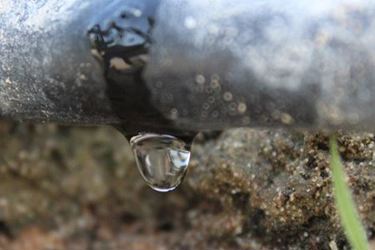Saving Water, One Drip At A Time

By Kevin Westerling,
@KevinOnWater

Water Online talks with renowned water expert, best-selling author, and N-Drip CSO Seth Siegel on the importance of freshwater conservation and sustainable water management.
We live in a world of great disparities — whether earned or unjust — but we should all agree that everyone deserves enough water for their basic needs, which is why worsening water scarcity is an urgent human crisis.
Thankfully, we have thought leaders such as Seth Siegel, author of Let There Be Water: Israel's Solution for a Water-Starved World, bringing the issue (and solutions) to the forefront.
Even better, the world seems to be listening.
Siegel’s 2015 book was a New York Times and Los Angeles Times bestseller and is now available in more than 50 countries. Along the way, it earned praise from the likes of Tony Blair, Michael Bloomberg, and Nobel laureate Shimon Peres. He then penned a follow-up in 2019, Troubled Water: What's Wrong with What We Drink, addressing the issue of water quality. But he’s more than just book smart…
Siegel’s water expertise is regularly put into practice as the chief sustainability officer at N-Drip, an Israeli agriculture technology startup, in addition to being a senior fellow at the University of Wisconsin’s Center for Water Policy.
And though his commentary has been sought by many — appearing in The New York Times, The Wall Street Journal, and The Washington Post; as a guest on various television and radio programs; and even in front of Congress and the UN — he participated in the following Q&A exclusively for Water Online.
You've been an ambassador for the importance of water, authoring numerous books on the subject. Is there a through-line connecting them, or a general inspiration behind them?

In addition, despite the essential nature of water and Water Online’s excellent coverage, I'm pained by the lack of media coverage on the topic. As such, I try to write for a general audience to raise awareness. While I hope every water professional will find substance of interest and value in my books, I'm intentionally reaching beyond the industry. I want intelligent readers with no water background to feel comfortable reading my work. No prior scientific, engineering, or technical experience is needed.
How did that lead you to your current role at N-Drip, to putting your words into practice?
I write with an agenda. I want to raise public awareness to spur action. Since I believe our leaders and others around the world have inadequately addressed the near-term and long-term effects of water scarcity, I was searching for a way of addressing that. At first, I thought I'd write a book about the revolutionary potential of N-Drip. But then, I decided to work from the inside to help accelerate the company’s efforts at making wasteful and utterly unsustainable flood irrigation a thing of the past.
Can you tie agricultural water use to issues beyond farmlands — how it trickles down (no pun intended) to other industries, municipal water operations, and public supply?
Agriculture accounts for 70% of all freshwater withdrawals in the U.S. While this is a traditional use of water that we have come to accept, irrigation could be more efficient. Around the world, 85% of all irrigated fields are flood irrigated. That is, more than 600 million acres are irrigated by flood irrigation in one name or another, including rice paddies, trench irrigation, and so forth.
Despite having access to more efficient technologies, farmers in the U.S. still use flood irrigation on more than 21 million acres (40% of all U.S. irrigated acres), including many in water-stressed watersheds. N-Drip reduces water use compared to flood irrigation by about half. That is an oceanic amount of water that can be saved and used for other purposes. Less water for agriculture means that much more water can be left in the system for other uses, such as industry and public supply and, of course, for the environment itself.
How is the technology itself disruptive for irrigation?
You have to start with the question: Why do farmers still use flood irrigation? Center pivot irrigation and pressurized drip irrigation were invented 85 and 65 years ago, respectively, but a significant number of farmers still choose to flood their fields. The answer comes down to agricultural economics.
Most farmers grow commodity crops (such as rice, alfalfa, cotton, potatoes, and corn) at very low margins. They can’t afford to switch to irrigation systems that are expensive to install and cost a lot of money to operate due to ongoing energy costs. But because N-Drip runs on gravity and requires no external energy, farmers can convert their flood-irrigated fields and get all the benefits of more expensive pressurized drip irrigation at a fraction of the cost. These benefits include significant reductions in water and fertilizer needed, increase in yield, and lower labor costs.
The conversion to N-Drip addresses several problems at once: water scarcity, water contamination from fertilizer, farm income, global food insecurity; and since the system significantly reduces greenhouse gases compared to flood irrigation, it is a big help in fighting climate change.
Are we addressing water supply issues adequately to surmount the problem, via policy and technology?
Too often, the answer is no. Even in the face of a developing crisis, bureaucracies are not comfortable with change. And when they embrace change, in principle, in practice, they tend to move very slowly. Here, you have a double effect. Farmers are often reluctant to change from the familiar to the unfamiliar, and government, even when motivated, rarely moves as fast as the need for change would suggest.
Because the agricultural sector is slow to change and scattered geographically in rural areas, some policymakers have turned their focus to “magic bullet” solutions, such as desalination or pipelines from faraway water sources, rather than address the significant inefficiencies existing within the watershed. They can best do that by addressing unsustainable irrigation practices, and most especially by helping farmers using flood irrigation to transition to more efficient irrigation systems.
What suggestions do you have for water-scarce areas in the U.S., particularly the Southwest?
More than six million acres in the Colorado River Basin, the most water stressed system in the U.S., utilize flood irrigation. By converting from flood irrigation to micro-irrigation, farmers will be able to save at least one acre-foot per acre, and sometimes a multiple of that. At scale, addressing agricultural water inefficiencies won’t just improve water levels in Lake Mead, but also provide a more sustainable future for the entire basin.
Is there a widespread practice you can point to that is either especially water-wasting and should cease, or one that is especially effective and should be adopted broadly?
Due to the intensity and expansion of drought across the country, the use of flood irrigation is no longer sustainable. These fields should be converted to N-Drip or other water efficient irrigation technologies, saving more than half of the water needed for flood irrigation. Because this conversion allows for more water to be available for other important uses, government officials, NGOs, and other water users, including many corporations, should partner with farmers and provide financial support for this conversion to support the farmers. Congress should continue to fund USDA to support financial assistance programs like the Environmental Quality Incentive Program (EQIP) and Rural Energy for American Program (REAP). States should continue to fund local programs administered by University Extensions and Natural Resources Districts (such as, the Water Irrigation Efficiency Program in Arizona and cost share programs with the Nebraska Natural Resources Districts).
Many farmers in the southwest U.S. are subject to a “use it or lose it” principle for their water rights, so they often are forced to utilize their full water right (even if their crops don’t need the water) in a wasteful manner. This principle disincentives farmers to use more efficient irrigation practices. States and federal entities should not punish farmers who participate in conservation programs and need to legally protect these water rights over a long term.
What predictions do you have for the future of water supply management on the municipal and/or industrial level?
Municipalities will need to address inefficiencies within their water systems and also identify new water sources, such as desalination. In addition to addressing wasteful flood irrigation in the agricultural sector, municipalities also will need to address aging water infrastructure. More than 1 trillion gallons (as much as 50% of the treated water in some places) is lost to leaks in the U.S. drinking water system.
Industry will need to be more accountable for their water use. Many companies, such as consumer package goods corporations that have agricultural products in their supply chain or tech corporations that require water for cooling in their computer processing data centers, will need to ensure that they are efficient as possible and not a drain on the watersheds in which they operate — especially in water-scarce areas.
Any final thoughts?
I've spoken a lot in this interview about flood irrigation and why I believe this wasteful, unsustainable method should be ended in partnerships between government, farmers, and other interested parties like growing municipalities and water-draining corporations. But I'd also like to say a few words in opposition to fallowing of farmland, a practice many policymakers like to use to increase the available water supply.
Fallowing is bad practice and lazy policy, and for several reasons. First, environmentally, it often leads to significantly enhanced airborne particulate matter in a wide area around the fallowed field. Fallowing also leads to higher temperatures in areas that are often already hotter than normal. In this case, we gain more water at the cost of worse air pollution and worse climate outcomes. Second, sociologically, fallowing leads to an increase in rural unemployment, forcing people at the very bottom of the socio-economic scale deeper into poverty and distress. And third, economically, fallowed fields create no concentric circles of economic opportunity, and local tax revenues fall. Local tractor dealers have fewer machines to sell and repair. Local seed companies sell less. Local services like lawyers and accountants have fewer transactions. And so on.
I'm obviously a great fan of N-Drip, but to put it into the context of fallowing, since an N-Drip converted field saves approximately half of the water compared to flood irrigation, for every two acres switched from flood irrigation to N-Drip, the government achieves the same water-saving result, but without all of the costs that fallowing impose. Before this technology existed, one could regret the use of fallowing, but understand why it might be necessary. But with the advent of transformational technology, fallowing should be taken out of the policymaker’s toolkit.
For further insights and reading, visit the N-Drip website and Seth Siegel’s author page on Amazon.
